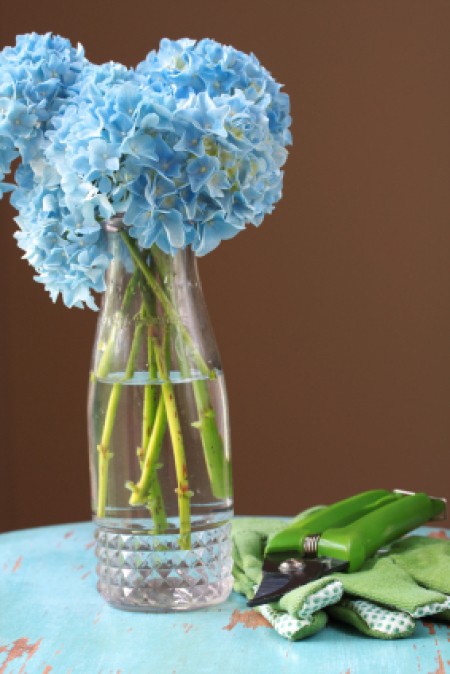
Every professional florist knows that the methods used to cut flowers and condition their stems can significantly extend their vase life. Here are a few easy tricks that will help you lengthen the life of the flowers you cut from your own garden - adding days of enjoyment to your floral arrangements.
When to cut: If you cut flowers during the heat of the day, they may already be droopy from the heat. Instead, cut them in the early morning, late afternoon, or evening when temperatures are cooler. Choose blossoms that are just about to open fully. Mature blooms that are heavy with pollen will not last as long as newly opened flowers.
The exceptions to this are daffodils and forsythia. Their tightly closed buds will not open up after they've been cut. Roses will continue to open as long as one outside petal has unfurled when cut.
Daisies, tickseed, and blanket flowers should be cut when the flowers are fully opened, but the centers are still firm and slightly green. Spiky flowers like gladiolus, lupine, and delphinium should be cut when lower flowers are in full bloom and upper buds are just on the threshold of opening.
What to use: Believe it or not, scissors are not the best tools for cutting flowers. They tend to crush the stems rather than severing them cleanly, which closes off the water channels in the stem that carry the water up to the flowers.
Picking flowers by hand isn't a good idea either, as you risk tearing the stems or uprooting the plants. The best tool for cutting flowers is a very sharp knife. If you can't find a sharp knife, a scissors or pruning shears will do, just make sure they are sharp.
How to cut: When heading out to the garden, take along a bucket of lukewarm water (100 to 110 degrees F) for transporting freshly cut flowers back to the house. When cutting, slice across the stems at an angle. This provides the largest surface area possible for water uptake and prevents the stems from resting on the bottom of the vase (which would also prevent water uptake).
The vase life of flowers can be extended significantly by conditioning the stems so they can absorb as much water as possible immediately after being picked. After cutting them, condition the stems appropriately according to type (see below), and let them stand in a bucket of lukewarm water (around 100 degrees F) for at least six to eight hours, in a cool, dark place.
It's okay to immerse the foliage, but be sure to keep the flower blossoms dry. Conditioning the stems in this way will let the flowers drink in the water and be at their sturdiest before you start to work with them in arrangements.
Woody Stems: The blossoms of some flowering trees, shrubs, and vines have woody stems that have difficulty taking up water. Examples include dogwood, forsythia, honeysuckle, lilac, mimosa, and apple trees, as well as flowers with fibrous stems like mallow, thistle, and chrysanthemum.
To condition their stems, strip off the bark 1 inch above the cut, then use a wooden rolling pin or rubber mallet to lightly crush the tip of the stem to break down the fibers. An alternative method is to use a sharp knife to cut a series of 1 inch long vertical slits up through the center of the base of the stem.
Milky Stems: The stems of some flowers are filled with a sticky, milk-like sap which prevents them from drawing up water when they are cut. If not conditioned properly, this oozing milky sap can quickly contaminate the rest of the flowers in your arrangement. Examples include daffodils, poppies, hydrangea, and hollyhocks.
To condition flowers with milky stems, cauterize (seal) the tips by passing them through an open flame or plunging them into a hot water bath. If you need to cut the stems to length when it's time to arrange them, you'll need to seal the tips again before placing them in a vase.
Hollow Stems: One of the secrets of conditioning flowers with hollow stems (e.g. amaryllis, daffodils, dahlias, delphinium, and lupine) is to fill the stems with water and then plug the openings. Simply hold each stem upside down and fill it with water using a medicine dropper. Tap the stems gently with your fingers to release any air bubbles, and plug the hole with a tiny, wadded up piece of a cotton ball. Return the flowers to their bucket of water until you are ready to arrange them.
Soft Stems: Soft-stemmed flowers should be cut longer in the garden, because when you bring them indoors you'll need to re-cut their stems under water. This is done to prevent air lock. Dunk the stem tips in a shallow bowl filled with water and use a sharp knife or pruning shears to re-cut the stems at an angle. Then condition the flowers in tepid water before arranging. If possible, cut the stems to the length you'll need in the arrangement before soaking them, so you can avoid re-cutting them.

About The Author: Ellen Brown is an environmental writer and photographer and the owner of Sustainable Media, an environmental media company that specializes in helping businesses and organizations promote eco-friendly products and services.
Add your voice! Click below to comment. ThriftyFun is powered by your wisdom!
Thank you, this is very handy advice! :-)
Very informative, though I have a question, the cut flowers should be immersed in the lukewarm water for 6 to 8 hours in a cool dark spot. Does that mean that you need to keep replacing the water to keep it lukewarm or just leave in the original bucket and let the water cool? I would appreciate any feedback. Thank you.
Add your voice! Click below to comment. ThriftyFun is powered by your wisdom!